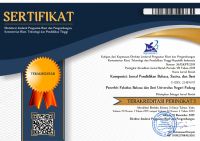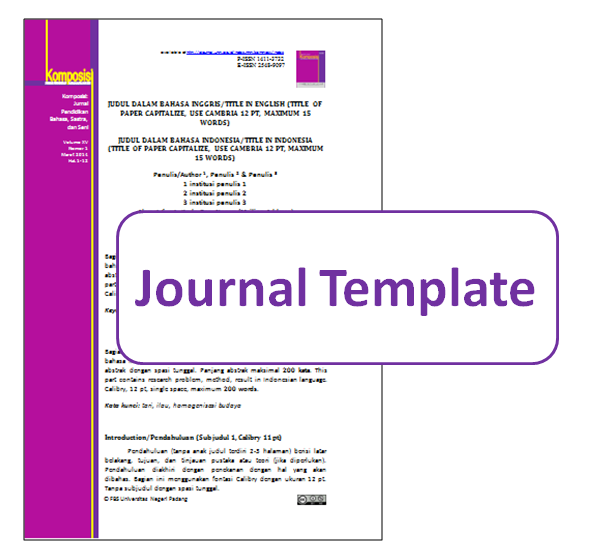COREOGRAPHY IN MALAYSIA IN MULTICULTURAL CONCEPT: CASE STUDY PROGRAM MINOR ARTS DANCE UPSI
 ),
), (1) Jurusan Sendratasik, FBS, Universitas Negeri Padang
 Corresponding Author
Corresponding Author
Copyright (c) 2017 Komposisi: Jurnal Pendidikan Bahasa, Sastra, dan Seni
DOI : https://doi.org/10.24036/komposisi.v15i2.7498
Full Text:
 Language : en
Language : en
Abstract
KOREOGRAFI DI MALAYSIA DALAM KONSEP MULTIKULTURAL: KAJIAN KES PROGRAM MINOR SENI TARI UPSI
Abstract
This writing is the result of my research entitled “Analisis Deskriptif Koreografi Pelajar Minor Seni Tari UPSI: Kajian Kes Tiga Produksi Tari 2008 – 2011”. The aim of the research is to answer the question: To what extend the dance work by Minor Dance Art students which was presented in Art Dance Production fulfills the coreography elements, by using descriptive analysis method from primary and secondary data. By using qualitative approach which involved library research, observation, interview and by using coreography theory, the research result proves that seventeen Minor Art Dance students’ dance works has been fulfilled the coreography elements. The elements are (a). The choice of theme or idea of work with the early stimulus, that is the stimulation of idea and concept, cinestetic, auditive, and visual. (b). Exploration and improvitation (c). Smoothing and composition. The composition elements has also been described, which include (1). The structure of the work (2). The body movement of the dancer (3). Th floor pattern (4). Music and lighting (5). Costum and make up, lighting. The research also found that eleven of students’ dance works has applied the multicultural concept which has ethnic and classic themes. The multicultural which is viewed as various of uniqueness and the diversity of the cultural ethnic, reflected by each work that is limited by historical context, social, and the origin culture, that includes Melayu ethnic, Minangkabau, Java, Sabah and Serawak, Kelantan, Hindia, and Chinese. Those eleven dances are Andai Randai, San Kipas, Iras, Ngayau, Tatoo Gendup Berpantang, Gawai Batu, Sekar Wangi, Kondattam, Sense of Beauty, Cinta Za’yu dan Jepit.
Keywords: Multicultural, Minor Dance, Coreography
Abstrak
Tulisan ini merupakan hasil penelitian saya yang berjudul "Analisis Deskriptif Koreografi Pelajar Minor Seni Tari UPSI: Kajian Kes Tiga Produksi Tari 2008 - 2011". Tujuan dari penelitian ini adalah untuk menjawab pertanyaan: Untuk memperluas tarian para siswa Seni Tari Minor yang dipresentasikan dalam Art Dance Production memenuhi elemen-elemen inti, dengan menggunakan metode analisis deskriptif dari data primer dan data sekunder. Dengan menggunakan pendekatan kualitatif yang melibatkan penelitian kepustakaan, observasi, wawancara dan dengan menggunakan teori inti, hasil penelitian membuktikan bahwa tujuh belas karya tari tari Seni Tunggal telah memenuhi unsur-unsur inti. Unsur-unsurnya adalah (a). Pilihan tema atau ide kerja dengan stimulus awal, yaitu stimulasi ide dan konsep, cinestetic, auditive, dan visual. (B). Eksplorasi dan peningkatan (c). Smoothing dan komposisi. Unsur komposisi juga telah dijelaskan, yang meliputi (1). Struktur pekerjaan (2). Gerakan tubuh para penari (3). Pola lantai (4). Musik dan pencahayaan (5). Costum dan make up, lighting. Penelitian ini juga menemukan bahwa sebelas karya tari siswa telah menerapkan konsep multikultural yang memiliki tema etnik dan klasik. Multikultural yang dipandang beragam keunikan dan keragaman etnik budaya, tercermin dari setiap karya yang dibatasi oleh konteks sejarah, sosial, dan budaya asal, yaitu etnis Melayu, Minangkabau, jawa, sabah dan Serawak, Kelantan, Hindia, dan Cina. Sebelas tarian tersebut adalah Andai Randai, San Kipas, Iras, Ngayau, Tatoo Gendup Berpantang, Gawai Batu, Sekar Wangi, Kondattam, Rasa Kecantikan, Cinta Za'yu dan Jepit.
Kata kunci: Multikultural, Tari Kecil, koreografi
References
Bagus, I Gusti Ngurah (2001). Reformasi, Multikulturalisme, Dan Masalah Politik Bahasa Indonesia, Makalah disampaikan pada Kongres Bahasa Jawa III. Yogyakarta: Badan Pekerja Kongres Bahasa Jawa.
Buku Program ReTari 2011.
Chris Barker. (2000) Cultural Studies.: Theory and Practice. London: Sage Publications.
Gonzales, Joseph (2004). Choreography A Malaysian Perspective.Kuala Lumpur: Akademi Seni Kebangsaan.
George Ritzer Doughlas j. Goodman (2004) Sociological Theory .terjemahan Nurhadi “Teori Sosiologi: Teori Sosiologi Klasik Sampai Perkembangan Mutakhir “. Edisi terbaru. New York: McGraw-Hill.
Hawkins, Alma M. (2002) Moving From Within: A New Method for Dance Making.Terj. I Wayan Dibia.Bergerak Menurut Kata Hati: Metoda Baru dalam Mencipta Tari. Denpasar: ISI.
Kurath, Getrude Prokosh. (1960) “Panorama of Dance Ethnology” dalam Jurnal Current Anthropology.
Royce, Anya Peterson. (1977) Anthropology of Dance.Indiana: Bloomington.
Sandra Cerny Minton. 1986. Choreography – A Basic Approach Using Improvisation (2nd edition). Human Kinetics
Siegel, Marcia B. The Shapes of Change: Image of American Dance. Houghton Miflin Company. Boston. 1979.
Smith. Jacqueline. Komposisi Tari: Sebuah Petunjuk Praktis untuk Guru. Terj. Ben Suharto. Yogyakarta: Ikalasti. 1985.
Sunderland. Margot. 1990. Choreography the Stage Musical. New York: J. Garnet Miller LTD
 Article Metrics
Article Metrics
 Abstract Views : 746 times
Abstract Views : 746 times
 PDF Downloaded : 139 times
PDF Downloaded : 139 times
Refbacks
- There are currently no refbacks.
Copyright (c) 2017 Komposisi: Jurnal Pendidikan Bahasa, Sastra, dan Seni











